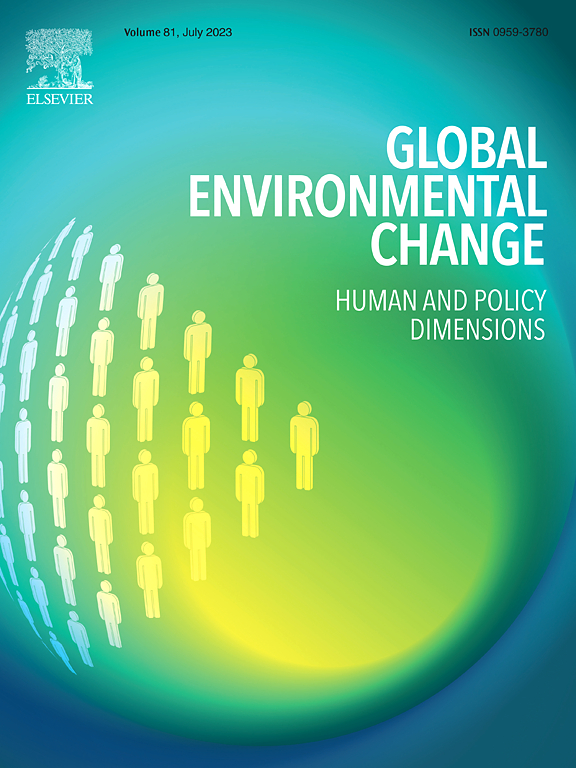Weathering change: Longitudinal patterns of residential mobility following extreme weather events in Australia
IF 9.1
1区 环境科学与生态学
Q1 ENVIRONMENTAL SCIENCES
引用次数: 0
Abstract
There is growing evidence of disaster-induced mobility. However, most research focuses on immediate displacement, limiting our ability to understand the long-term consequences of extreme weather events on residential mobility. To address this gap, this study establishes the relationships between home damage caused by bushfires, floods, and cyclones and ensuing residential mobility in the following five years. Using nationally representative individual-level data from the Household, Income and Labour Dynamics in Australia (HILDA) Survey from 2009 to 2023, we use finite distributed lag logistic models to determine the level, timing, and direction of weather-induced mobility, distinguishing between onward and return movement and distance moved. While most moves occur in the immediate aftermath of an extreme weather event, results indicate that weather-induced home damage increases the odds of moving for up to three years. Four distinct mobility patterns emerge: (1) immediate relocation, which brings some moves forward, (2) delayed displacement up to three years later, particularly over short distances, (3) short-term displacement followed by return, and (4) repeat onward migration. Younger adults and renters are more likely to be involved in all mobility types. Tertiary-educated individuals are less likely to return, but more likely to move repeatedly, while separated individuals are more likely to be delayed movers. The diversity of mobility responses underscores the conceptual and methodological complexities of estimating weather-induced population movement and the need for nuance and caution, while showing the benefits of distributed lag models to capture time dynamics. Our findings also highlight the need for targeted support mechanisms that account for different mobility trajectories and varying constraints faced by sub-population groups in the aftermath of extreme weather events.
风化变化:澳大利亚极端天气事件后居民迁移的纵向模式
越来越多的证据表明,灾害导致了人口流动。然而,大多数研究都集中在即时迁移上,限制了我们理解极端天气事件对住宅流动性的长期影响的能力。为了解决这一差距,本研究建立了森林大火、洪水和飓风造成的房屋损失与随后五年的住宅流动性之间的关系。利用2009年至2023年澳大利亚家庭、收入和劳动力动态(HILDA)调查中具有全国代表性的个人层面数据,我们使用有限分布滞后逻辑模型来确定天气引起的流动性的水平、时间和方向,区分前进和返回的移动以及移动的距离。虽然大多数搬家都是在极端天气事件发生后立即发生的,但研究结果表明,天气导致的房屋损坏会增加长达三年的搬家几率。出现了四种不同的迁移模式:(1)立即迁移,这带来了一些向前的迁移;(2)延迟迁移长达三年后,特别是在短途迁移中;(3)短期迁移之后返回;(4)重复向前迁移。年轻人和租房者更有可能参与所有的流动类型。受过高等教育的人不太可能回来,但更有可能反复搬家,而分居的人更有可能推迟搬家。流动响应的多样性强调了估算天气引起的人口流动的概念和方法的复杂性,以及对细微差别和谨慎的需要,同时显示了分布式滞后模型在捕捉时间动态方面的好处。我们的研究结果还强调,需要有针对性的支持机制,以解释极端天气事件后亚人口群体面临的不同流动轨迹和不同限制。
本文章由计算机程序翻译,如有差异,请以英文原文为准。
求助全文
约1分钟内获得全文
求助全文
来源期刊

Global Environmental Change
环境科学-环境科学
CiteScore
18.20
自引率
2.20%
发文量
146
审稿时长
12 months
期刊介绍:
Global Environmental Change is a prestigious international journal that publishes articles of high quality, both theoretically and empirically rigorous. The journal aims to contribute to the understanding of global environmental change from the perspectives of human and policy dimensions. Specifically, it considers global environmental change as the result of processes occurring at the local level, but with wide-ranging impacts on various spatial, temporal, and socio-political scales.
In terms of content, the journal seeks articles with a strong social science component. This includes research that examines the societal drivers and consequences of environmental change, as well as social and policy processes that aim to address these challenges. While the journal covers a broad range of topics, including biodiversity and ecosystem services, climate, coasts, food systems, land use and land cover, oceans, urban areas, and water resources, it also welcomes contributions that investigate the drivers, consequences, and management of other areas affected by environmental change.
Overall, Global Environmental Change encourages research that deepens our understanding of the complex interactions between human activities and the environment, with the goal of informing policy and decision-making.
 求助内容:
求助内容: 应助结果提醒方式:
应助结果提醒方式:


